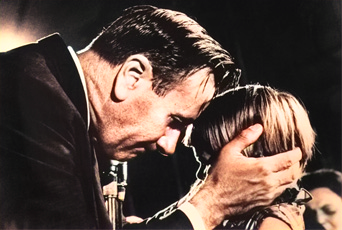BAXTER, W. J. E. (“ERN” – William John Ernest) (1914-93)
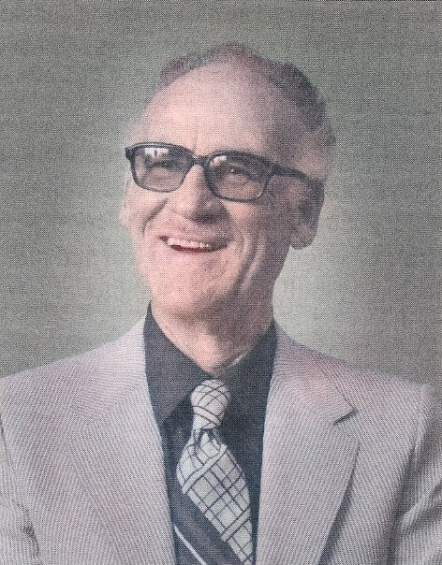
BAXTER, W. J. E. (“ERN” – William John Ernest) (1914-93)
Ern Baxter’s influence on the worldwide charismatic community at the end of the 20th century should not be underestimated. He was an influential leader and major change agent amongst Pentecostals, the Healing Revival, the Latter Rain Movement, the Charismatic Renewal and the Apostolic Church Movement.
Early life
He was born into a Presbyterian family on June 22,1914, in Saskatoon, Saskatchewan, Canada. His mother became involved with a holiness church but after his father’s conversion they attended a Pentecostal church. A Scandinavian minister with a “signs and wonders” ministry visited Saskatoon and taught on the baptism in the Holy Spirit. Ern Baxter’s mother was the first in those meetings to receive the “baptism of power.” He recalled seeing his father help her into the house ‘drunk in the Spirit’.
In his teenage years, young Ern rebelled against what he saw as legalism and emotionalism in the church and effectively lost his faith. In 1932 he became seriously ill with pneumonia but it was a blessing in disguise. He was supernaturally healed and subsequently recommitted his life to Christ.
Ministry
As a gifted musician he began to travel as the pianist for an evangelist called N. V. Brown on 24 May 1932 and on July 2,1932, he received a personal baptism with the Holy Spirit during a conference on the Holy Spirit, held in Trossachs, Canada, that same year . The next morning, he said God spoke to him and called him to the ministry saying, “I want you to preach My Word”.
He noticed that many attendees of the Trossachs conference chose to follow either the Word or the Spirit and would compromise on one or the other. He loved both and spent some time ministering within classic Pentecostalism, but found his Reformed theology unacceptable amongst them. Then he received an invitation to a small independent Baptist church in Vancouver in British Columbia, Canada, called the Evangelistic Tabernacle. It was here he put into practice those principles of the Word and the Spirit that he had experienced at Trossachs. The church became the largest church in the city and the surrounding area.
First contact with William Branham
While flying to a holiday destination in Winnepeg with his wife, he read about William Branham in a Time Magazine on the airplane. During dinner his host, a prominent businessman in Winnipeg, said, “There’s an unusual minister down at Zion Church. His name is William Branham.” Ern explained he’d just read about this man on the airplane. So, they decided to attend, that night.
They arrived around nine o’clock in the evening at a rather large church which seated around two thousand. They were shocked to see a crowd of people outside, listening to Branham by loudspeakers because they couldn’t get inside. Ern and his friend were fascinated by Branham’s simple preaching, direct but attractive preaching about demons and God’s power to heal. He had a sense that he was going to have something to do with this man.
On returning home Branham’s reputation as a healing evangelist had spread like wildfire. When Ern learned Branham was ministering in Calgary, Alberta he decided to take some of his people to experience this unusual man and his ministry.
Due to Branham’s heavy load of personally ministering to thousands each night, other ministers who could handle large crowds were invited to share the afternoon meetings. Because Ern was known in Calgary, he was invited to take one afternoon service, speaking on the theme “This is the day that the Lord hath made; we will rejoice and be glad in it.”
He returned home after two or three days, to find a number of ministers meeting to discuss inviting Branham to Vancouver.” The invitation was sent and Ern was asked to lead the meetings, which he did.
Ern’s report of the Vancouver meetings was written for a local publication and later reprinted in the in the April 1948 edition of the Voice of Healing Magazine, pages 1-2: “Scenes of indescribable glory were witnessed during the all-too-brief, four-day, citywide campaign with Rev. William Branham. As in other cities, so in Vancouver, the largest available auditoriums were inadequate to accommodate the teeming multitudes that waited on the ministry of our brother. Surrounding towns and villages seemed to literally empty into Vancouver, until the whole city was conscious of the spiritual impact of thousands of praying, believing people. Ministerial delegations from various cities attended with a view to securing the ministry of Brother Branham for similar meetings in their various fields of labor. Thousands were unable to gain access to the meetings, and this in spite of a transportation strike involving all street cars and buses.”
“The Vancouver meetings were preceded by three mass prayer meetings, and three great preparation services on the day before the meetings commenced. Right from the beginning of negotiations for the coming of Brother Branham to Vancouver, a salutary spirit of unity and cooperation prevailed among the Vancouver ministers. This gracious spirit continued, and in fact increased throughout the meetings, and is yet very much a reality, finding expression in fellowship groups and meetings. We have noted this to be one of the outstanding features of Brother Branham’s ministry in other cities, also. And how desperately it has been needed.”
“Many testimonies of healing have continued to come to the attention of local pastors, and many marvelous works were wrought by the immediate action of the Holy Spirit at the time of prayer. To undertake any kind of a report on the healings experienced would be an impossible task, for should one speak of crossed eyes straightened, or of bed-ridden invalids raised, or of the deaf hearing, or of the dumb speaking? Or should one seek to recount the thrilling testimonies of those relieved of cancers, tumors and goitres? The task is too great, and when seemingly completed, it has only begun. Final records will only be read when we stand before the Giver of every good and perfect gift.” (See original article)
Joins William Branham’s team
 Soon after, Branham asked to see Ern privately and told him he had been in prayer and the Angel of the Lord had spoken to him and told him that he was to be his companion in ministry. He invited Ern to join his team which consisted of himself, Young Brown, Jack Moore and Gordon Lindsay.
Soon after, Branham asked to see Ern privately and told him he had been in prayer and the Angel of the Lord had spoken to him and told him that he was to be his companion in ministry. He invited Ern to join his team which consisted of himself, Young Brown, Jack Moore and Gordon Lindsay.
Ern was already a highly gifted minister. He was an able worship leader with musical ability and a strong voice. He had a broad range of Biblical knowledge and theological understanding, gained not by a college education but by years of personal reading and research. He had grown a large church which had required an evangelistic anointing and a high level of organisational skills.
Above all he was an outstanding conference speaker, an orator without parallel. His ability to expound the word of God was extraordinary. He often held his hearers spell-bound, captivated by an incomparable ‘anointed’ eloquence and solid theology. Always exalting the majesty of God, His sovereignty and His glorious works through Jesus Christ. Ern combined lofty theology, insightful exposition and practical application with occasional dashes of humour which swept his audiences along like a leaf on a torrent of living water. His exposition of Bible history and biographies made the hearers feel the emotions, challenges, struggles and victories of the Biblical characters. The present writer had the privilege of hearing him a number of times in the 70’s when he spoke to various ‘restoration church’ gatherings in the UK. He will always be remembered as one of the greatest Christian preachers of the 20th Century. Ern had a unique gift of presenting the ‘bigger picture’ of all the great biblical doctrines and themes he touched upon, especially God’s purpose of ultimately bringing everything under His government, ruling the nations through the redeemed community. This comment on his ministry in 1951 from the Voice of Healing magazine well describes his spoken ministry Here you can view one of the few printed sermons from Ern
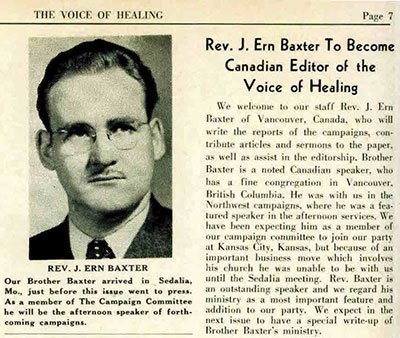 He was unusually multi-gifted and served William Branham’s ministry in a variety of ways. He immediately became the Canadian editor of the Voice of Healing Magazine as well as campaign manager. This was announced in the May 1948 edition of the Voice of Healing, p7. In addition he conducted the daytime meetings during the Branham crusades to build up the faith of the attendees with his extraordinary teaching gift, preparing the vast crowds for the main evening meetings with Branham. For seven years he took time out from his church in Vancouver faithfully serving this highly anointed healing evangelist. These intense ministry trips were anything up to eight months of the year and were very exhausting. He worked alongside Branham and was a valuable asset to his ministry, preparing the hearts of people who came for healing. This excerpt from the report of the Bellingam, Mass., meetings of June 1949 make this clear (see here EB_4908-2-16-Bellingham) So prominent was his ministry in the Branham campaigns that there were often called the ‘Branham-Baxter Campaigns.’
He was unusually multi-gifted and served William Branham’s ministry in a variety of ways. He immediately became the Canadian editor of the Voice of Healing Magazine as well as campaign manager. This was announced in the May 1948 edition of the Voice of Healing, p7. In addition he conducted the daytime meetings during the Branham crusades to build up the faith of the attendees with his extraordinary teaching gift, preparing the vast crowds for the main evening meetings with Branham. For seven years he took time out from his church in Vancouver faithfully serving this highly anointed healing evangelist. These intense ministry trips were anything up to eight months of the year and were very exhausting. He worked alongside Branham and was a valuable asset to his ministry, preparing the hearts of people who came for healing. This excerpt from the report of the Bellingam, Mass., meetings of June 1949 make this clear (see here EB_4908-2-16-Bellingham) So prominent was his ministry in the Branham campaigns that there were often called the ‘Branham-Baxter Campaigns.’
He had a privileged ringside seat observing William Branham’s ministry, describing in detail his gift. “Branham had a tremendous word of knowledge. Before praying for a person, he would give accurate details concerning the person’s ailments, and also details of their lives – their hometown, activities, actions – even way back in their childhood. Branham never once made a mistake with the word of knowledge in all the years I was with him. That covers, in my case, thousands of instances.”
Ern Baxter’s reports on various meetings make interesting reading. This was one of the early brief reports of a series of meetings at Calgary, Alberta in Canada. The unique mission to Finland in early was covered in detail and can be read in this PDF. Click here to view.
In 1952 the Branham party, including Ern held a 10-week campaign in South Africa, with extraordinary results. The Branham party and the local organisers can be seen on this image. Ern is on the right of the picture on the first row. Of course Branham’s healing ministry was the most spectacular, but the ministries of F.F. Bosworth and Ern Baxter were equally anointed. See here for Julius Stadsklev’s report from the March 1952 edition of the Voice of Healing Magazine.
“Branham’s use of the word of knowledge actually started out as a phenomenon in his hand. He would take the hand of the person in his. Immediately at the base of his thumb, in the thick part of his hand, there would be a specific manifestation according to the sickness or need. From seeing the phenomenon so often, I began to pick up what these were and became adept at reading them. Tuberculosis was a light pink flush. Cancer was an angry red appearance in which the ball of his thumb would just seem to surge like a wave.”
Baxter’s growing disillusionment with the Healing Movement
Pastoring coupled with his itinerant teaching ministry, left Baxter severely fatigued over the years. Then he began to have misgivings about the Healing Revival. At the beginning of the movement, God did spectacular things which shook the countless thousands who attended meetings around the world, but particularly in the US. They were glorious days! The men he used were serious seekers of God’s best who had a passion for authentic New Testament Christianity. They were committed to Scripture, honoured Jesus Christ above all things, they spent time praying and fasting, sometimes for extended periods of time. They had all the hallmarks of godly men. But, because such times and experiences had not been known since the early twentieth century Pentecostal outpouring, the leaders of which had largely gone to glory, there were no living examples or mentors on hand to guide these anointed ministries.
It soon became apparent to Baxter that storms were brewing and the dams would burst. The major ministries had experienced a meteoric rise to fame amongst the churches. This was to be expected as the church had been without much activity of the Holy Spirits power for many years. The churches were hungry for supernatural ministries like those of the old Pentecostal revival a generation before. But the men God chose did not handle things wisely. They were too independent – lone-rangers in the Kingdom – with no accountability. This resulted in far too many shipwrecks and breakdowns, bringing disillusion and discouragement to many.
Competitiveness and pride led to misleading reports, exaggerated statistics of attendance, tent size, magazine circulations and so on. Despite appeals from Gordon Lindsay for integrity, humility and unity, the movement continued to spiral into an unconnected and unaccountable free for all. Baxter wrote an article expressing his concerns entitled, “The Curse of Carnal Comparisons,” in which he highlighted the growing Corinthianism in the healing movement. Needless to say, this counsel was ignored by the healers.
There were also issues of financial unaccountability and theological immaturity which marred the movement. Then, as reputable journalists began to investigate some of the claims, they discovered many were not untrue. Though there were authentic and verifiable healings, the carnal disposition of a few made claims that did not pass careful scrutiny. As a result, disillusionment set in and the healing movement began to decline in popularity. Baxter later commented about his misgivings (probably 1991). Click here.
Baxter’s departure from William Branham
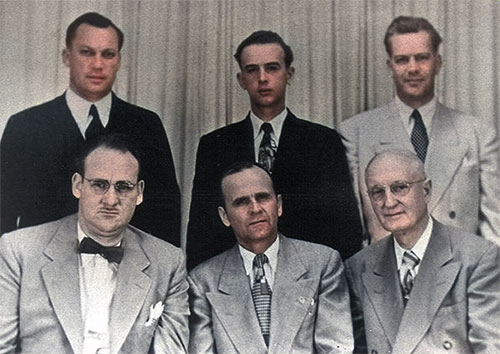
Front row: Ern, Branham, Bosworth
As the movement fell into decline Baxter also began to have concerns about William Branham’s ministry. He believed that Branham was starting to preach things that were “seriously wrong” (New Wine Interview, Dec 1978). It is clear that Baxter believed in Branham’s ministry during their early years of ministry, but his doubts gradually increased.
He noticed that Branham’s teaching on faith seemed like the repetition of an autosuggestion, that he likened to ‘Couism.’ (a kind of ‘metaphysical positivism’ which taught that the continual repetition of a thought or idea would bring results eg healing etc)
Branham was not a teacher, he was a healing evangelist and when he tried to teach he was outside his calling and anointing. It was as if Branham was teaching people to have faith in their faith, or to concentrate on and cultivate their faith, rather than looking to the Healer, Jesus Christ. He noted: “This bothered me and I saw it was an ‘out’ to accommodate people who weren’t getting healed. ‘There must have been something wrong with their faith.’ And so that disturbed me.” (source)
He said “there were aspects of the supernatural that began to disturb me.”
“And I don’t know just how far to go with this but l began to be disturbed with some of the phenomenon that were occurring – some of them, I felt, were good, others I felt were borderline psychic. And I became quite disturbed about it. I continued with Branham until I felt that in my conscience I couldn’t go on.” (Writers note: Baxter did not think the phenomenon were demonic but were the results of autosuggestion or the power of the human mind)
It was these kind of misgivings and the destructive, carnal incursions that had entered the healing movement that caused Baxter to step down from his position as manager and principal teacher in Branham’s campaigns. This was in 1954.
He had become so disillusioned that he soon resigned from his church. After a period of rest Baxter started a small storefront church in Vancouver, the Open Bible Chapel, which grew to several hundred members.
Ern Baxter and the Latter Rain
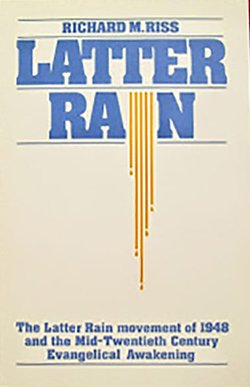 Baxter was hugely influenced by the Latter Rain movement and was responsible, with others, for the spreading of their teachings in the early charismatic movement, though he was never ‘officially’ a Latter Rain man. Nor was William Branham.
Baxter was hugely influenced by the Latter Rain movement and was responsible, with others, for the spreading of their teachings in the early charismatic movement, though he was never ‘officially’ a Latter Rain man. Nor was William Branham.
William Branham’s ministry was clearly the starting point of the Healing Revival, from which most of the other ministries took their lead. Some were already actively involved in the healing ministry, like F. F. Bosworth, a veteran of the earlier Pentecostal revival and Thomas Wyatt, whose healing ministry dates from the late 1930’s. A. A. Allen, Oral Roberts and T. L. Osborn were all deeply affected by attending Branham campaign’s and were inspired to follow his lead.
But in 1948 there was another movement of the Holy Spirit that broke out in Canada – The Latter Rain. The leaders of a small Pentecostal, group in North Battleford, Saskatchewan were seeking a deeper level of Christianity after the ministry of the Spirit initially experienced by the Pentecostals, had began to wane. After visiting a Branham meeting in Vancouver they returned to their home church and began to pray and fast for extended periods, in search of a new anointing of the Holy Spirit.
Richard Riss who has documented the mid-twentieth century evangelical awakening in America quotes George Hawtin: “The truth of fasting was one great contributing factor to the revival. One year before this we had read Franklin Hall’s book, entitled ‘Atomic Power With God Through Fasting and Prayer.’ We immediately began to practice fasting. Previously we had not understood the possibility of long fasts. The revival would never have been possible without the restoration of this great truth through our good brother Hall.”
Their fasting proved fruitful! The Spirit began to visit them with great power, with baptisms in the Holy Spirit through the laying on of hands, gifts of the Spirit, notably prophecy, Spirit-inspired worship with congregational singing in tongues, etc.
One of the leaders was George Warnock who had been a secretary for Baxter a couple of years, prior to the new outpouring. Warnock had received the baptism of the Holy Spirit in Baxter’s home and had received his calling to the ministry in a young people’s prayer meeting after one of Baxter’s church services. When the Latter Rain revival broke out Warnock went back to his home in North Battleford to be a part of it. Later he wired Baxter about their second conference which was to be held in Edmonton, Canada. Baxter said, “George was a very low-key person – he was not given to hyperbole and exaggeration. Sometimes he was so low – hey, you felt you wanted to bring him up a little! But when he sent me the telegram to me saying, “You must come to this conference – this is it! (This) really got my attention”
“And I don’t want to go into all the details but I felt I had some divine direction to go. Well when I got to this conference, the place where it was held was jammed and there was no question that there was a lot of spiritual activity and it was exciting and it was challenging and it was refreshing,” but he felt the teaching was deficient and that the leaders were using this dynamic move of the Spirit to promote their questionable views. “Since I knew personally the leaders of the Latter Rain I spoke to them about some of those things, but they were caught up in the euphoria of it and I personally enjoyed the experience of the moving of the Spirit.”
Baxter went to their second convocation in Canada and said; “I never saw such a concentration of the power of God”.
It is unclear what ‘questionable views’ he referred to but it is clear that initially, as the movement was young and it’s leaders were inexperienced, there was a lot of truth but there was error mixed in too.
Nevertheless, there were a number of Latter Rain emphases which found their way into the Charismatic Renewal Movement some years later. These include singing in the Spirit, dancing, the restoration of the fivefold ministries of Eph. 4.11, and the laying on of hands to receive ministry the Baptism of the Holy Spirit, prophecy and healing) and personal prophecy from regular Christians, not just from ministry leaders. How much of these teaching Ern Baxter embraced at the time is unknown, but he had certainly adopted many of them into his teaching ministry by the time he became more fully engaged with charismatic leaders in Fort Lauderdale.
But Latter Rain teachings were not embraced by the burgeoning denominational charismatic renewal. They were too ‘restorationist’ and their ecclesiology, recognising the authority of non-local apostles and prophets, could find no place withing the tightly structured denominational structures. They were happy with the various manifestations of the Holy Spirit which brought a sense of God’s presence and renewal to thousands of their members, but the great leap from their models of ecclesiastical to this radical New Testament approach was a step too far.
The Slow Road to Fort Lauderdale
Details of this period of Baxter’s life are very scanty and all we have are the basic events of these times. After a period of rest, he returned to Vancouver and began teaching and preaching again at a small storefront church called Open Bible Chapel. Due to his discouragement and disillusion with the carnality and doctrinal irregularities of the Healing and Latter Rain Movements he no longer majored on the issues of supernatural manifestations and the phenomenological ministry of the Holy Spirit. His first wife passed away in 1961.
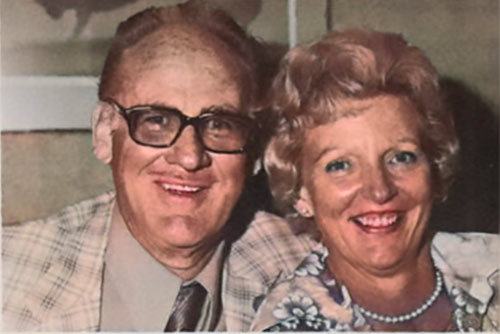 But in 1964 he married his second wife, Ruth, and for the next six years he served as a Bible teacher in various churches in the U.S. while continuing to travel in ministry. He moved back to Canada in 1970.
But in 1964 he married his second wife, Ruth, and for the next six years he served as a Bible teacher in various churches in the U.S. while continuing to travel in ministry. He moved back to Canada in 1970.
One day he read in a magazine of an Episcopalian priest named Dennis Bennett who had started speaking in tongues, went public with it and had to relocate to a small church which happened to be two blocks from a Bible college at which he regularly taught. They soon met and became great friends.
Bennet’s church grew quickly and he became a leading voice in the burgeoning Charismatic Movement across the US. Soon Lutherans, Catholics, Presbyterians, Baptists and other ministers were coming together expressing a true “Unity of the Spirit”. It was exciting!
In course of time Baxter began to see those familiar enemies of Holy Spirit activity emerging again. He called these enemies ‘Corinthianism.’ The movement began to experience the problems that arise when the Spirit and the Word are not held in proper tension and when biblical guidelines and godly oversight are not in place.
Other teaching participants in the Charismatic Renewal shared the same concerns as Baxter and began to develop teachings to counteract the human tendencies that marred the Spirit’s work. “Some of these people simultaneously began to teach on growth, discipleship, shepherding, order, relationship, order, covenant and other themes related to the whole process of growing up.”
At this time the first Shepherds Conference in Leesburg, Florida was held with about 500 delegates while Baxter was out of the country but he was invitated to address more than 1, 700 men who attended the second conference held in Montreat, North Carolina in 1974. It was here he became associated with the group of brothers who were involved with “Christian Growth Ministries” and New Wine Magazine. They were Don Basham, Derek Prince, Bob Mumford and Charles Simpson. He was soon invited to join this group of leaders.
Christian Growth Ministries
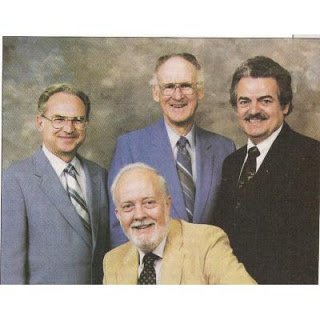
Four of the Fort Lauderdale 5, excludung Derek Prince.
Ern Baxter is possibly most known for being part of what was called the Shepherding/Discipleship Movement. While there is no denying that excess and harm was indeed present in this movement, the original vision and heart of the five men who led the movement were for God’s highest best and so that moves of the Spirit of God would be maintained and heightened. Don Basham, Derek Prince, Bob Mumford, Charles Simpson and Ern Baxter all came from different theological and religious viewpoints and backgrounds yet realised that there is nothing biblical or healthy in independence. In no way whatever did any of the five men support unbiblical heavy shepherding but they did call for a need for accountability and discipleship. The five men held several major key conferences at Montreat and at Kansas which attracted many thousands of men – suggesting that their message was meeting a need. The Kansas City Shepherds Conference in 1975 was especially historic – attended by some 40 to 50, 000 men. Ern Baxter closed the conference preaching possibly his most historic message – “Thy Kingdom Come!”. Many men testified to seeing angelic manifestations and signs and wonders. The sense of unity brought an awesome and heavy manifestation of the anointing of the Presence of God.”
One of the true landmark moments in the history of the Charismatic Movement was when 5,000 leaders from all major backgrounds gathered in Kansas City to hear Brother Ern deliver his now-famous message, “Thy Kingdom Come”. The congregation pulled off their shoes and worshiped the Lord in response. Many who attended still say it was the best Bible teach message they have ever heard. Another message for which he is well-known is “Life on Wings” or “The Eagle Sermon”.” Charles Simpson’s tribute.
His worldwide ministry
From those early days he exercised his powerful prophetic preaching bringing fresh hope, revelation and vision to thousands of believers across the world. Motivated by his triumphant eschatology and passion for a new Testament style of church entire movements were realigned with what they saw as God’s end-time purposes.
Baxter ministered in various parts of the world particularly UK and Australia. In 1975 he preached at Bryn Jones seminal Bible week held in the grounds of Capel Bible College, near Dorking, Surrey. This writer well remembers visiting one evening when brother Ern held the 2,000+ visitors spell-bound with his address on David and Jonathan. He also preached keynote addresses at the main charismatic conferences – the Lakes and Dales Bible Weeks.
Andrew Walker wrote;
“Baxter’s influence was sensational; the audiences went wild every time he appeared … during the first Bible Week at the Great Yorkshire Showground in 1976, Baxter was the great attraction and as in the previous year excitement was at fever pitch”.
Terry Virgo, the father of the Newfrontiers family of churches wrote;
“Ern Baxter was a powerful prophetic preacher, able to paint a huge picture of the magnificent end-time church. He was deeply rooted theologically, very widely read but also profoundly steeped in a powerful Pentecostal background … the influence of Ern Baxter and his friends was growing even greater in the USA and their monthly magazine New Wine became their radical trumpet voice was now being read all around the world”.
In conclusion
In his later years he believed in the principles of discipleship and took on 12 pastors to mentor and support whenever he could. These men would travel to his home, firstly in Mobile, Alabama, and then in San Diego, California, to spend time hearing him teach. He travelled as much as his health would allow, supporting and visiting his “sons” and their churches. Even at the end of his life, he was taking an interest in imparting all that he had learned to younger men – his “Timothys”.
Thousands of leaders around the world look back with gratitude to God that they too, were products of his unsurpassed teaching ministry.
Helpful sites to explore futher:
Broken Bread Teaching – A comprehensive collection of Ern Baxter’s teaching audio’s
Life on Wings – A tribute to Ern Baxter – An assortment of comments and materials on Ern Baxter
The Latter Rain Movement ‘1948 – An excellent resource on all Latter Rain teachings and leaders


